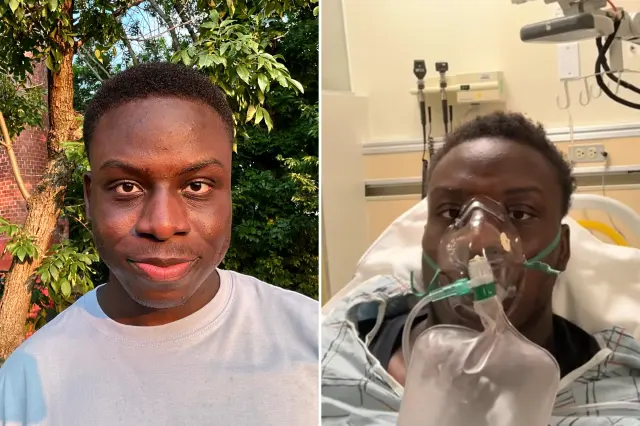-
Tuning In - 24 mins ago
-
California atmospheric river intensifies: Here’s the latest forecast - 28 mins ago
-
LSU Makes Final Decision on QB Garrett Nussmeier Before Arkansas Game - 32 mins ago
-
Marjorie Taylor Greene takes new swipe at Trump - about 1 hour ago
-
Maps Show How Latinos Who Shifted Right in 2024 Snapped Back Left in 2025 - about 1 hour ago
-
South L.A. merchants, residents frustrated as homelessness persists - about 1 hour ago
-
Suspect arrested after attack on Alina Habba’s office, Pam Bondi says - 2 hours ago
-
California to revoke 17,000 commercial driver’s licenses issued to immigrants - 2 hours ago
-
Displaced Gazans Face More Misery as Torrential Rain Lashes Enclave - 2 hours ago
-
MAGA Reacts As Donald Trump Cuts Ties WIth Marjorie Taylor Greene - 2 hours ago
Man, 24, Thought His Chest Pain Was Work Stress, Then Gets Shock Diagnosis
A Gen Z man who developed chest pain thought he was just stressed from work and overexerting himself, but to his horror, he actually had a life-threatening condition.
In September, Sammy Ouatts, 24, started to feel increasingly fatigued and didn’t quite feel like himself. He told Newsweek that he initially blamed it on a hectic schedule and all the New York Fashion Week events he was attending at the time.
As the symptoms progressed, Ouatts also developed sharp and aching pains in his ribcage, chest pressure, and shortness of breath. But still he believed it was all just lifestyle factors.
“At the time I thought the cause of my symptoms was work,” Ouatts said. “I worked at a popular bakery, and it was always busy. The job is fast-paced and can be physically demanding at times.
“The pain in my ribcage got so bad to the point that I couldn’t sleep at night. Laying down and putting pressure on my ribs would trigger sharp radiating pain throughout my body.”

Prior to the symptoms, Ouatts, of Brooklyn, New York, could walk for hours without issue. However, once the symptoms started, even walking up a single flight of stairs made him feel like he’d just “ran a marathon.”
For a while, Ouatts tried to quash the ribcage pain with Ibuprofen and hoped stretching would alleviate the discomfort. He was also just getting over a cough and wondered if the symptoms were caused by chest congestion.
The relief was only temporary, and before long, he was suffering in pain once again.
On October 10, after around three weeks of symptoms, Ouatts went to the emergency room “out of desperation.” He wanted answers, and a doctor suggested it was inflammation of the cartilage connecting his ribs to the sternum. Ouatts was given a higher dosage pain killer, which helped briefly.
Ouatts said: “However, my attempts at alleviating the shortness of breath and chest pressure via over-the-counter medicine gave me a false sense of healing, and it was too late.”
After using all of his sick hours, Ouatts was due to return to work on October 16. Prior to his shift, he decided to test his fitness by walking up the stairs in his apartment building—a simple enough task, surely.
He’d nearly reached the top of the stairs when the pain kicked in once again. He felt weak, and it didn’t matter how hard Ouatts tried to breathe, he just couldn’t get sufficient oxygen in.
Ouatts was driven to the hospital immediately by a friend, and he underwent several tests and scans. For so long he presumed it was just the stress of work and a busy schedule, but the results showed a much bigger problem.
“Minutes later I was told that I had two major blood clots in my lungs, one in each, close to my heart that blocked the blood flow,” Ouatts said. “My right ventricle was extremely large due to strain. If I wasn’t treated sooner, I could have suffered a heart attack and died that day—or at any point in the last few weeks.”
A pulmonary embolism is a blood clot in one of the blood vessels in the lung. It’s a medical emergency as the clot restricts blood flow, lowers oxygen levels and increases blood pressure. It’s considered one of the most common heart and blood vessel diseases globally, as The Cleveland Clinic suggests that around 900,000 people a year get a pulmonary embolism. Tragically, a third of people with the condition die before receiving a diagnosis.
Hearing those words was unfathomable to Ouatts, who still doesn’t know how or why this happened. He’s only 24, doesn’t smoke, vape or even drink alcohol. And while blood clots are known to impact those with a very sedentary lifestyle, Ouatts is always on the go.
“I had knowledge about what pulmonary embolisms are, but I never thought in a million years that it would happen to me,” he told Newsweek.
Ouatts was rushed into an operating theater for a suction thrombectomy to remove the blood clots. He remained in hospital for a few days and was prescribed blood thinners to prevent further clots.
Thankfully, Ouatts is doing much better now and hasn’t experienced any further breathing problems. The mental toll of a sudden lifechanging diagnosis like that is hard to shake though, and Ouatts has become “hyper focused” on every feeling in his body.
One thing he has learned from this experience is to make healthier choices and to take better care of himself.
Ouatts shared a video on TikTok (@sammyouatts) revealing how he “almost died,” and the nightmarish story has horrified many. With over 15,800 views and 1,700 likes on the TikTok post so far, Ouatts hopes others will learn to take their own health seriously too.
He said: “I have never experienced something as life-threatening as this before. This experience has humbled me and made me reflect on the fact that life is so fragile. You could be okay in one moment, and on the verge of death the next.
“Surround yourself with people who pray for you and wish you well, because I truly believe that the support of my family and friends allowed me to be in a better condition. Take care of yourself and listen to your body, but don’t let the fear of something bad happening consume you.”
Source link

















